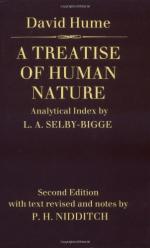It appears, therefore, that of these seven philosophical relations, there remain only four, which depending solely upon ideas, can be the objects of knowledge said certainty. These four are resemblance, contrariety, degrees in quality, and proportions in quantity or number. Three of these relations are discoverable at first sight, and fall more properly under the province of intuition than demonstration. When any objects resemble each other, the resemblance will at first strike the eve, or rather the mind; and seldom requires a second examination. The case is the same with contrariety, and with the degrees of any quality. No one can once doubt but existence and non-existence destroy each other, and are perfectly incompatible and contrary. And though it be impossible to judge exactly of the degrees of any quality, such as colour, taste, heat, cold, when the difference betwixt them is very small: yet it is easy to decide, that any of them is superior or inferior to another, when their difference is considerable. And this decision we always pronounce at first sight, without any enquiry or reasoning.
We might proceed, after the same manner, in fixing the proportions of quantity or number, and might at one view observe a superiority or inferiority betwixt any numbers, or figures; especially where the difference is very great and remarkable. As to equality or any exact proportion, we can only guess at it from a single consideration; except in very short numbers, or very limited portions of extension; which are comprehended in an instant, and where we perceive an impossibility of falling into any considerable error. In all other cases we must settle the proportions with some liberty, or proceed in a more artificial manner.
I have already I observed, that geometry, or the art, by which we fix the proportions of figures; though it much excels both in universality and exactness, the loose judgments of the senses and imagination; yet never attains a perfect precision and exactness. It’s first principles are still drawn from the general appearance of the objects; and that appearance can never afford us any security, when we examine, the prodigious minuteness of which nature is susceptible. Our ideas seem to give a perfect assurance, that no two right lines can have a common segment; but if we consider these ideas, we shall find, that they always suppose a sensible inclination of the two lines, and that where the angle they form is extremely small, we have no standard of a I @ right line so precise as to assure us of the truth of this proposition. It is the same case with most of the primary decisions of the mathematics.




